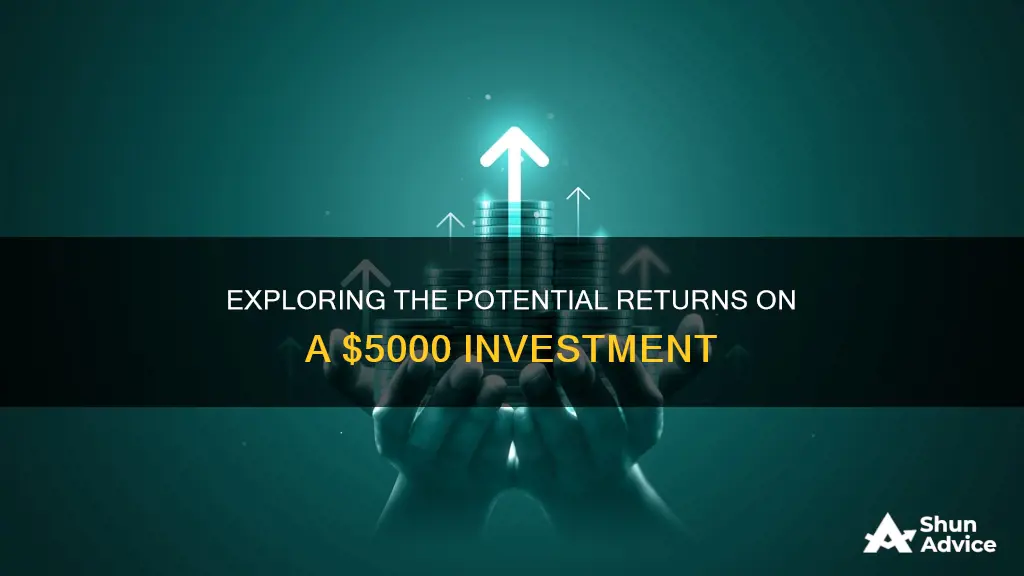
The total value of an investment of $5,000 depends on a variety of factors, including the rate of return, the length of the investment, and any additional contributions made during that time. For example, an investment of $5,000 with a 6% annual interest rate will be worth $16,036 at the end of 20 years, whereas an investment with an 8% return will be worth $23,305 in the same period. The length of the investment is also important, as longer investments generally carry more risk due to the unforeseeable future, but they also accrue more compounding returns, leading to greater rewards.
What You'll Learn

Future value of a $5000 investment in 5 years
The future value of an investment is the value of a current asset at a future date based on an assumed growth rate. It is calculated to estimate how much an investment today will be worth in the future. The future value of a $5,000 investment in 5 years will depend on the rate of return and the type of interest.
Simple Annual Interest
If the investment earns simple interest compounded annually, the future value (FV) is calculated using the formula:
$$FV = PV \times (1 + r)^n$$
Where:
- FV = Future value
- PV = Present value (original $5,000 to be invested)
- R = Interest rate per period
- N = Number of periods (5 years)
For example, if the interest rate is 10%, the FV of the $5,000 investment is:
$$FV = $5,000 \times (1 + 0.10 \times 5)$$
Compounded Annual Interest
If the investment earns compound interest, the rate is applied to each period's cumulative account balance. The formula for the FV is:
$$FV = PV \times (1 + r)^{nt}$$
Where:
- FV = Future value
- PV = Present value
- R = Interest rate per period
- N = Number of periods
- T = Time in years
Using the same example, the FV of the $5,000 investment with a 10% compounding interest rate would be:
$$FV = $5,000 \times (1 + 0.10)^5$$
Impact of Interest Rate and Investment Fees
The future value of a $5,000 investment over 5 years can range from $5,520.40 to $18,564.65, depending on the interest rate. For example, with a 2% interest rate, the FV would be $5,520.40, while a 30% interest rate would result in an FV of $18,564.65.
It is important to consider investment fees, which can significantly impact returns. For instance, a 1% fee on a $5,000 investment with a 5% return can reduce the future value.
Movie Investment: Why Take the Risk?
You may want to see also

How to calculate compound interest
To calculate compound interest, you will need to know the compound interest formula:
> A = P(1+r/n)^nt
- A = the future value of the investment
- P = the principal balance
- R = the annual interest rate (in decimal form)
- N = number of times interest is compounded per year
- T = the time in years
- ^ = to the power of
Let's say you invest $5,000 in a savings account for 10 years at an annual interest rate of 5%, compounded monthly.
First, convert the annual interest rate to a decimal:
> r = 5/100 = 0.05
Next, plug the figures into the formula:
> A = 5000 × (1 + 0.05 / 12)^(12 × 10)
Now, calculate the result:
> A = 5000 × (1.004167)^(120)
> A = 5000 × 1.647009
> A = 8235.05
So, the investment balance after 10 years is $8,235.05.
To calculate the interest earned, subtract the principal balance from the result:
> Interest = 8235.05 - 5000
> Interest = 3235.05
Therefore, the total interest earned on an investment of $5,000 over 10 years at an annual interest rate of 5%, compounded monthly, is $3,235.05.
Future Fortunes: Unlocking the Power of Compounding
You may want to see also

Investment plans with fixed rates of return
When it comes to investing, there are a variety of options available, each with its own unique characteristics and potential benefits. One such option is fixed-income investments, which offer a steady stream of returns on a fixed schedule. Here are some investment plans with fixed rates of return:
Individual Bonds
Bonds are a common form of fixed-income investment. When you purchase a bond, you essentially lend money to a corporation or government entity. In return, they become liable to pay you a sum of money, known as coupon payments, at regular intervals. Additionally, you receive the principal loan amount back at maturity. By holding bonds until maturity, investors can maximise their returns.
Exchange-Traded Funds (ETFs)
ETFs are another type of fixed-income investment that are traded on stock exchanges. They are actively managed by fund managers who adjust the portfolio based on changes in interest rates and economic conditions. ETFs tend to garner more profit due to their equity-like functioning. Gold ETFs, for example, are a popular choice among investors.
Debt Funds
Debt funds are considered low-risk, low-return investments. They invest in safer instruments such as government and corporate bonds, rather than volatile stock markets. Debt funds are ideal for investors seeking stable returns over the long term.
Money Market Funds
Money market funds are best suited for short-term investments, typically up to 90 days. They generate steady income and include instruments such as commercial papers, short-term certificates of deposit, and banker's acceptance. However, they are directly impacted by increases in interest rates.
Public Provident Fund (PPF)
The Public Provident Fund is a popular scheme for long-term investment, backed by the Government of India. It offers attractive interest rates that are fully tax-exempt, making it a tax-efficient investment option. The investment duration is 15 years, with the option to extend in blocks of five years. The maximum investment amount per year is INR 1.5 lakh.
Bank Fixed Deposits (FDs)
Bank fixed deposits are similar to regular savings accounts but offer a higher rate of return. They provide guaranteed returns while keeping the principal amount secure. FDs usually have a lock-in period during which investors cannot make withdrawals. This option is particularly attractive to risk-averse investors.
Retirement Plans
Retirement plans, also known as pension plans, are insurance-cum-investment plans. The insured pays a regular premium to the insurance company during the policy tenure. Upon retirement, the insured receives regular payouts in the form of annuities. In the event of the insured's death, their beneficiary receives the sum assured. Retirement plans provide a steady source of income during retirement.
Monthly Income Plans (MIPs)
Monthly Income Plans (MIPs) are debt-oriented hybrid mutual funds that provide periodic payouts every month. As market-linked products, the returns on MIPs are not guaranteed but depend on the fund's performance. MIPs offer higher returns than conventional fixed deposits, typically in the range of 11-14%. There is no upper cap on the investment amount or lock-in period for MIPs.
Senior Citizen Savings Scheme
The Senior Citizen Savings Scheme is a government-backed investment option for investors over the age of 60 who are in a low tax bracket. It offers a regular stream of income with a time frame of 5 years, which can be extended by an additional 3 years. The maximum investment allowed is INR 15 lakh.
Pradhan Mantri Vaya Vandana Yojana (PMVVY)
The PMVVY is implemented through the Life Insurance Corporation of India (LIC) and aims to provide social security to senior citizens aged 60 and above. It offers an assured pension based on a guaranteed rate of return of 8% per annum for 10 years. The investment limit for this scheme is INR 15 lakh.
These investment plans offer fixed rates of return and are suitable for conservative investors seeking stable and predictable income. However, it is important to carefully consider the risks and potential returns associated with each investment option before making a decision.
Silver: Inflation Hedge
You may want to see also

Risk factors in bond investments
While bonds are considered a safe investment option, they are not devoid of risks. Here are some of the key risk factors associated with bond investments:
Interest Rate Risk:
This is one of the biggest risks in bond investing. When interest rates rise, bond prices tend to fall as investors favour newer bonds with higher interest rates. Conversely, when interest rates fall, bond prices rise as the higher payouts on existing bonds become more attractive. This inverse relationship between interest rates and bond prices can impact the value of an investment.
Reinvestment Risk:
Reinvestment risk refers to the possibility that investors will have to reinvest the proceeds from a bond at a lower interest rate than the original bond. This often happens when interest rates fall, and issuers call back their bonds, leaving investors to reinvest at less favourable rates.
Inflation Risk/Purchasing Power Risk:
Inflation risk refers to the impact of inflation on bond returns. As inflation rises, the purchasing power of bond returns decreases, meaning the same amount of income will buy fewer goods. This can significantly affect the value of an investment over time.
Credit/Default Risk:
Credit risk is the probability that the bond issuer will be unable to make timely payments or default on their debt obligations. This risk depends on the financial health of the issuer and their ability to repay. Default risk can result in partial or total loss of investment for investors.
Liquidity Risk:
Liquidity risk arises when bonds are difficult to sell in a narrow market with few buyers and sellers. Such markets are characterised by low liquidity and high volatility, making it challenging to liquidate bond holdings.
Market Risk/Systematic Risk:
Market risk refers to the potential for losses due to market downturns or rate changes. In a bond market, even good investments can lose value when the overall market declines. Interest rate risk is a form of market risk that specifically affects bonds.
It's important to note that understanding these risks is crucial for investors to make informed decisions and diversify their portfolios. Proper assessment of these risk factors can help mitigate potential losses and create a more efficient market.
Reliance Industries: Invest Now?
You may want to see also

How to calculate future value (FV)
Future value (FV) is the value of a current asset at a specific point in the future based on an assumed growth rate. It is important for investors and financial planners as it helps them estimate how much an investment today will be worth in the future.
There are two ways to calculate the FV of an asset: one formula assumes simple interest, and the other assumes compound interest.
Simple Interest
The formula for calculating the FV of an investment with simple interest is:
> FV = PV x [1 + (interest rate x time)]
Or
> FV = PV x (1 + r) ^ n
- FV = Future Value
- PV = Present Value (the initial balance of your investment)
- R = interest rate (expressed on an annual basis)
- N = the number of periods (years) the money is invested for
For example, if you invest $5,000 at a simple interest rate of 10% per annum for 5 years, the FV of your investment will be:
> FV = $5,000 x [1 + (0.10 x 5)]
> FV = $7,500
Compound Interest
With compound interest, the rate is applied to each period's cumulative account balance. The formula for calculating the FV of an investment with compound interest is:
> FV = PV x (1 + r) ^ (nt)
- FV = Future Value
- PV = Present Value
- R = interest rate per period
- N = number of periods
- T = time in years
For example, if you invest $5,000 for 5 years at a compound interest rate of 10% per annum, the FV of your investment will be:
> FV = $5,000 x (1 + 0.10) ^ 5
> FV = $5,000 x 1.61
> FV = $8,050
Using a Calculator
You can also use a future value calculator to determine the FV of an investment. This is especially useful if you want to account for more variables, such as periodic deposits or annuity payments. To use a calculator, you will need to input the following:
- Present value (initial investment)
- Interest rate (expressed on a yearly basis)
- Number of years invested
- Compound frequency (the number of times the interest is compounded per year)
Crypto Investments: Legal or Not?
You may want to see also
Frequently asked questions
This depends on the interest rate and the length of the investment. For example, an investment of $5,000 with a 6% annual interest rate will be worth $16,036 at the end of 20 years.
The formula for calculating the future value of an investment is: FV = PV x (1 + r)^n, where FV is the future value, PV is the present value or original amount, r is the rate of return, and n is the number of periods.
Compound interest is interest that is calculated on both the initial amount invested and any interest that has been accumulated. In other words, interest earns interest. Compound interest can significantly increase the final balance of your investment over time, especially with higher compounding frequencies and interest rates.







